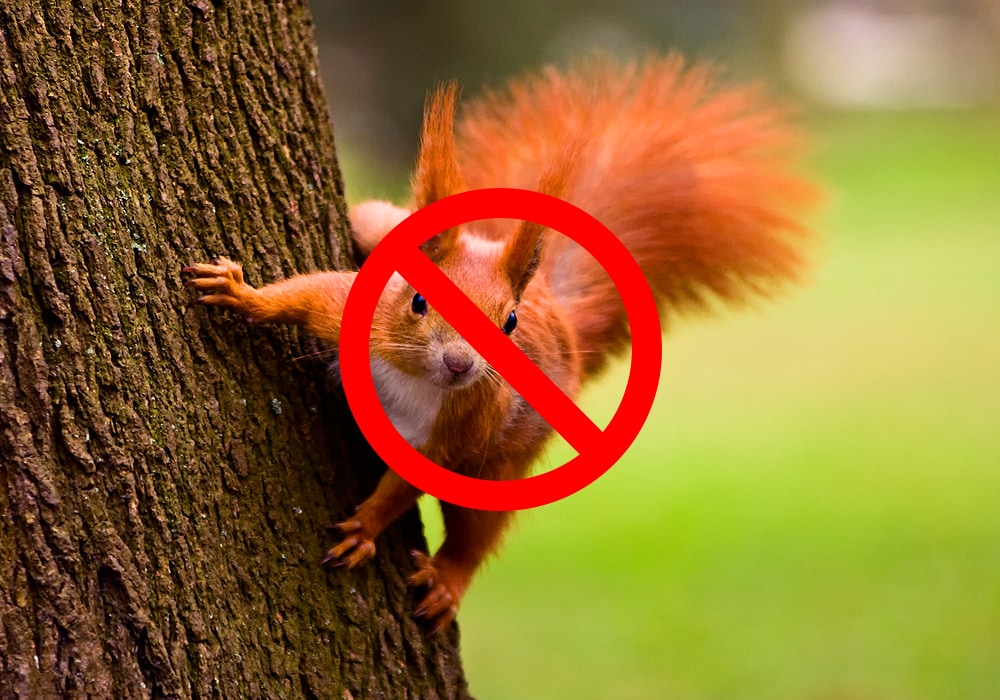Here at World Birds, we love our backyard wildlife. But what happens when a favorite backyard visitor starts to cause problems? Squirrels may be cute to look at when they’re running around up trees and nibbling on acorns, but once they’re in your attic tearing up the walls, you’ll be singing a different tune.
Whether they’re ransacking your birdfeeders, digging up your seedlings, or making themselves at home in your house, there are plenty of ways that squirrels can bring a bit of mischief into your life. But that doesn’t mean you have to abandon your love for your local wildlife. There are plenty of humane ways to encourage these little trouble-makers to find a new place to hang out.
Find out how to get rid of squirrels safely, effectively, and humanely with these tips. Just remember to check your local laws and pursue squirrel deterrents responsibly. Coexisting with native wildlife is an important responsibility and pest control methods for native animals should be both ethical and humane.
1. Install a motion activated sprinkler
Squirrels are naturally jumpy creatures. They’re small and only have their teeth and jaws to fight off danger. When they’re faced with something scary, they tend to pick flight over fight most of the time.
To scare away squirrels, you don’t need much. You don’t need to inflict pain or cause any harm. A sudden movement or a sudden sound is enough to make them run away. And a motion-activated sprinkler is a great place to start.
Most people are iffy with sprinklers because they can drive up your water bill fast. To avoid this, choose one that has a lot of customizable settings. That way it only activates when you need it to and you can cut down on the amount of water it uses.
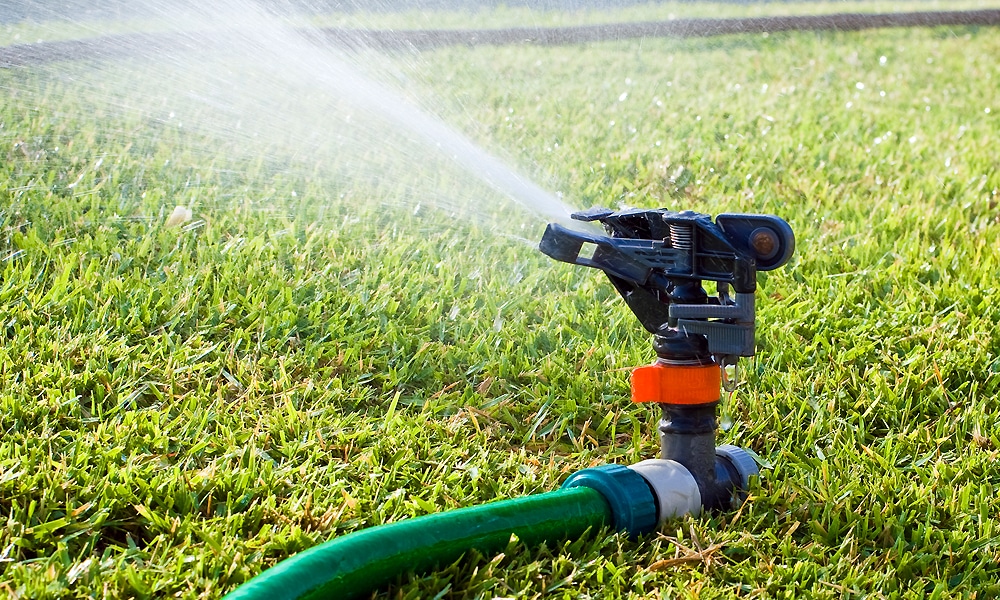
Proper motion-activated sprinklers allows you to choose if you want it on during the day, during the night, or 24/7. It should also have a high tech sensor that is able to distinguish between the movement of animals and movement caused by the wind.
You can adjust the sensor’s angle depending on the height of the animal you’re trying to get rid of. Just connect to your hose and drive into the ground using its spike.
Then, adjust the settings according to your needs, and let it work its magic. If there was ever a safe, non-toxic, and all-natural squirrel repellent, it’s got to be a spray of water!
Over time, you might find that your backyard squirrels get used to sprinklers. As flighty as they are, squirrels adapt to new things quickly and can be very stubborn. Try using this method in conjunction with other methods and reposition your sprinkler once in a while to keep them on their toes.
2. Use squirrel-proof bird feeders
Bird feeders are squirrel magnets. The buffet of delicious grains, seeds, nuts, and fruits are hard to resist. These critters can climb up and take all the food for themselves, leaving your home bird-less.
But lucky for us, there’s such a thing as squirrel-proof bird feeders. These feeders will stump the squirrels in your yard so that they eventually learn that it isn’t the best source of food in the neighborhood. And all while still supplying your backyard birds with plenty of birdseed!
Premade squirrel-proof feeders are great, but there are also a lot of DIY ways to protect your existing bird feeders from these little pilferers. And most of them are pretty entertaining!
You can suspend your feeder on a wire instead of sticking it on the ground. Make sure it hangs at least five feet from the ground to prevent them from jumping. I have heard of particularly determined squirrels sliding down the wire or jumping down from above, but this method at least makes your feeder harder to reach.

You can make sure they don’t reach it through the wire so easily by threading a plastic bottle on either end as a makeshift squirrel baffle. It’s fun to see them try to move past the bottle when they realize it keeps rolling on the wire!
If your bird feeder is mounted on a stake, you can also place a baffle on it. A squirrel baffle can be a barrier to the feeder or a way to widen the pole such that a squirrel can’t grip it. You can buy one at the store or make one yourself.
If you want to have fun watching these critters try and fail to get at your bird seed, attach a slinky to the bottom of the feeder and allow it to dangle down. When the squirrels grasp it, their weight pulls it all the way back down! Squirrel deterrents can be humane and entertaining!
3. Plant flowers squirrels hate
You might think squirrels love all things green. After all, their diet consists of berries and seeds, and they make their homes in tree trunks. But there are actually such things as squirrel deterrent plants.
To squirrel proof gardens, plant flowers that are either brightly-colored or emit a strong smell. Plants squirrels hate include fritillaries, geraniums, hyacinth, galanthus (AKA snowdrops), lily-of-the-valley, mint, and daffodils. Just be careful when planting mint to get rid of squirrels. It’s a stubborn plant that has a tendency to take over gardens!
Daffodils are off-putting to squirrels and they won’t eat them because they contain lycorine and calcium oxalate crystals that are toxic when ingested.

Looking for some plants that deter squirrels while also contributing to your herb garden? Alliums include onion, garlic, leeks, and scallions. They’re tasty to humans, but the taste and smell of alliums repel squirrels naturally. The smell of mint may be pleasant to humans, but if you check what smells deter squirrels, it’s also pretty high on the list.
Use these plants as a way to support your other squirrel removal efforts. Grow them near entry points into your yard to deter squirrels from coming in. Place them strategically around tree trunks to prevent these animals from climbing up and getting to the fruits.
Position them around the walls of your home to discourage squirrels from coming near at all. These bright and pungent flowers not only get rid of squirrels; they also make your garden come alive with color. The more natural squirrel repellants you use, the less attractive your garden will be for squirrels and the more attractive it will be for humans!
Bonus: many of the flowers that repel squirrels actually attract other lovable garden visitors. Pollinators like hummingbirds love geraniums!
4. Use mulch
If you have a problem with squirrels ruining your carefully-tended garden, there is a solution that can drive the critters away and make your plants grow even better: mulch.
Mulch is any material that is placed above the soil to maintain moisture, prevent weed growth, and keep away pests. But exactly what do squirrels hate about mulch?
If you’re looking for something that will primarily act as a squirrel deterrent, it’s best to use inorganic mulch such as gravel, pebbles, plastic sheeting, rubber chips, or chicken wire.
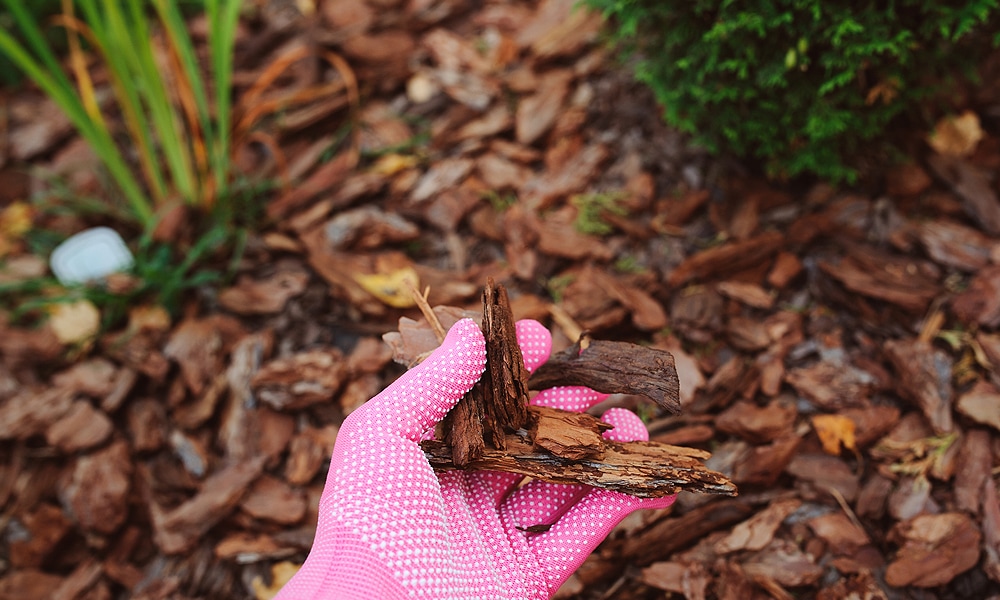
Organic mulch like shredded grass, leaves, hay, and straw is too much like what squirrels naturally dig up, and they will usually find it easy to get through to the soil. Inorganic mulch is much stronger and has a texture that squirrels detest digging up. We recommend pebbles, gravel, and chicken wire to cut down on environmentally harmful plastic waste.
This is also a good way of getting rid of ground squirrels that like to make their homes by digging up soil rather than hanging out in the trees.
To get rid of squirrels in the garden, apply mulch on the soil at least 12 inches on all sides of your plants. If using plastic sheeting, cut out a hole to let the plant stem go through. It may be worth noting that many say the best squirrel repellent in terms of mulch is to layer gravel over chicken wire.
If you can stop squirrels digging up your garden, you might even have an easier time tolerating their presence in your yard otherwise. Mulch is great solution to help you repair your relationship with your uninvited backyard guests.
5. Test an ultrasound squirrel deterrent
Studies show that squirrels can hear sounds over a frequency range that is more than twice as wide as ours. Their range is skewed towards ultrasound, which refers to sounds that are at a higher frequency than what is audible to the human ear.
This important scientific discovery has spurred the development of ultrasonic squirrel repeller devices. If you are looking for something effective, non-toxic, and humane, this is the best squirrel repellent for you.
This sonic squirrel repellent device is popular because of its adjustable settings, durability, and solar powered charger.
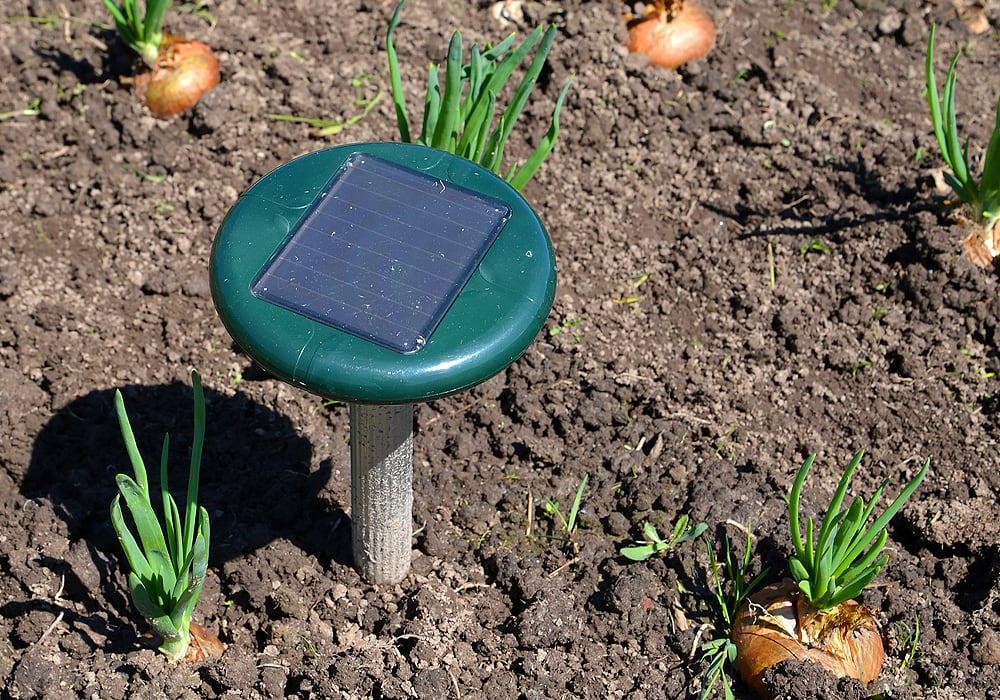
You can choose from five frequency settings depending on the animal you want to get rid of. For squirrels, turn the knob to 3. As it emits sound, it also flashes bright LED lights that serve as another squirrel repellent.
Position the device in a spot that receives full-on sunlight to take advantage of its solar energy capabilities. Although during overcast days, you can also charge it using its USB port.
The sensor scans the surroundings at a 110-degree angle, but this can be adjusted if you want a narrower range. It can detect movement from up to 30 feet away, so position it within that distance to their usual entry points to make the most of the squirrel repellent sound device.
6. Remove food sources
If you want to stop squirrels from coming onto your property, you need to understand why they love hanging out there in the first place. More often than not, it’s because of food.
First, let’s try and answer the question: “What do squirrels eat?” In the wild, squirrels mostly eat plant material. But living side by side with humans in urban and suburban settings, these little critters can and do eat almost anything and everything. Squirrel problems can start from leaving pet food out, installing an easily-accessible bird feeder, planting fruiting trees, or failing to secure trash bags.
So before you start installing squirrel fence spikes or buying gallons of squirrel poison, know that the best way to repel squirrels is not applying something they hate but taking away something they love.

Avoid leaving your pet’s food bowl outdoors. Install a squirrel guard on the pole holding up your birdfeeder, or else buy one that is squirrel-proof.
Tent protective netting over your fruiting trees and protect your vegetable garden with hardware cloth or chicken wire. Remove any fallen fruits or bird feed from your yard. Put your garbage in a sturdy trash can that has a lockable lid.
Removing food sources should be your first move in the squirrel control battle strategy. Without doing this, you significantly decrease the chances of success of your other pest control squirrels methods. Squirrels are determined and crafty and they will come back to a yard that tempts them with their favorite foods, even with deterrents in place.
7. Remove entry options to the house
For squirrels, human homes are understandably very attractive. It’s well-insulated, offers protection from the elements and predators, and is likely close to a steady source of food.
So if there is a crack big enough for them to squeeze into, you can be sure they’ll try. If you’re wondering how to keep squirrels away from your home, the simplest solution is to block them from coming in at all.
Walk around your home and take note of any possible entry points, like a crack in the foundation, a hole in the screen door, or water-damaged eaves. Fill these in with sealant.

Your best bet to close up gaps and stop squirrels from biting through and making their own entry points is copper mesh paired with expandable foam. The strong teeth and powerful jaws of these rodents are no match for a solid copper mesh.
These thin sheets of metal are pliable and can be easily stuffed into openings of different shapes and sizes. Fill in the tiny gaps in the mesh by applying the foam with a foam applicator gun.
This keeps water and dust from seeping in through the crack. Paint over the foam once fully dry, and you’ll never know a hole was there in the first place.
Keep squirrels away by removing anything they can use to scale up your walls. This includes pruning tree branches and vines that graze the walls and removing firewood leaning at the side of your house.
8. Use a decoy squirrel feeder
You might be thinking, “Wait a second. I thought tip #6 was to remove all food sources?”. Well, think of that tip as part 1 of this tip.
The only way a decoy squirrel feeder is going to be effective is if you first eliminate feeding opportunities in your own home. You must make it as easy as possible for these critters to choose the decoy over your house.
The decoy squirrel feeder should have the most squirrel-enticing buffet of food ever. Fill it with everything they like to eat, and make sure there’s enough for everyone. The idea here is to embrace the squirrels in your yard instead of chasing them off.

It’s best to choose a spot with hollow trees for tree squirrels and soft ground for ground squirrels. With the killer combination of a steady food source and good real estate, there should not be any reason for them to go back to your home. This method can also help reduce their presence at your birdfeeders. If they have a chock-full feeder of squirrel-approved treats just a few yards away, why should they bother brute forcing their way around your squirrel-proof feeders?
There are a lot of innovative squirrel feeders in the market that might just help repair your relationship with these so-called pests.
You can buy one that is made for mounting corn cobs and laugh at how they nibble at the food. You can also purchase feeders where the food is placed inside a cage and watch them figure out how to remove the nuts from the grills.
Learning to love the squirrels in your yard and discourage them from causing problems is the best win-win solution to your squirrel woes.
9. DO NOT scare squirrels with mousetraps
Mousetraps are one of the more violent pest control products, but some people insist that when used correctly, they can be used to repel squirrels without hurting them.
When a mousetrap snaps, it is a loud crack of sound that immediately scares animals away. This is the principle behind the use of these devices for squirrel control.
Animal welfare laws and basic humanity dictate that these products should not be used in the traditional way for squirrels. Again, you should not be harming native wildlife. It’s both shortsighted and can be illegal depending on where you live.
But even using mousetraps to scare squirrels can have unintended consequences. Setting mousetraps outdoors is often not even legal because you have no control over what animals might wander into your traps.
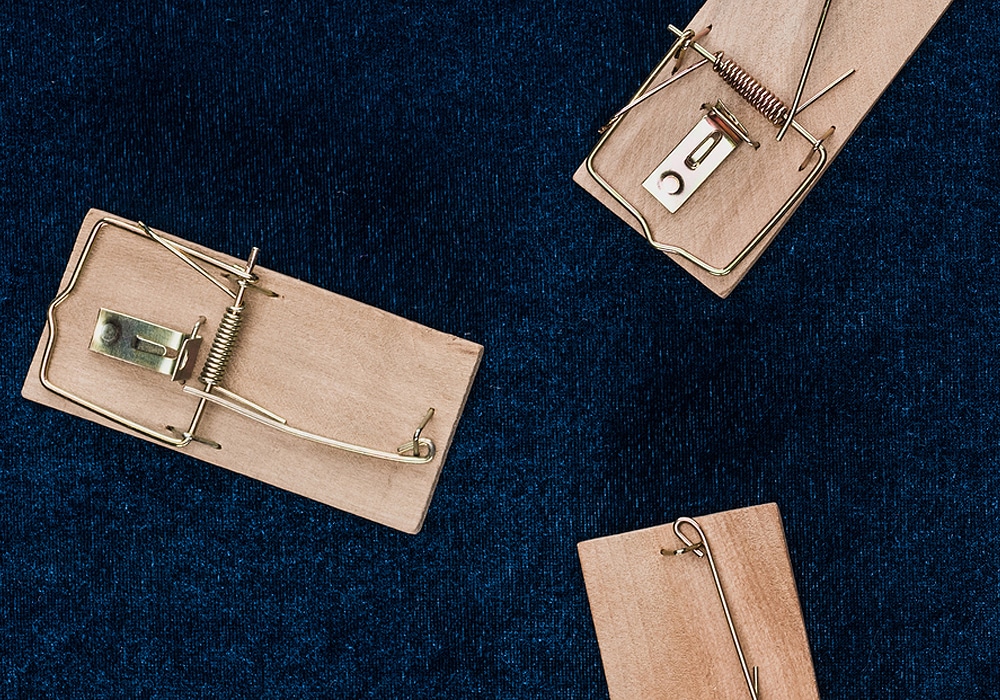
Anchoring mouse traps to the ground may present them from jumping upwards (and even that is a maybe), but it won’t completely prevent squirrels or other creatures from getting caught or injured. If your squirrel problem is severe enough that you’re considering mousetraps as an option, it may simply be time to call up a pest control expert and get some advice.
10. Try natural squirrel repellents
There are a lot of chemical sprays on the market that are effective at getting rid of squirrels, but they may cause toxicity in animals and humans and be detrimental to the environment. Instead, try to make your own natural squirrel deterrent spray using food-grade products.
The key to making an effective squirrel spray is to use ingredients that these critters hate. One of the easiest to find are pungent essential oils and spices.
Anything that tastes and smells spicy or minty will make squirrels run away. Mixing a bit of peppermint oil into a gallon of water is a cheap and easy DIY natural squirrel deterrent.

To use this squirrel repellent for the garden, spray around the areas where squirrels are most likely to enter your garden or home.
If you want to protect your trees, you can add a raw egg to the mixture. This makes it more viscous and sticky, perfect for applying on tree bark. The residue will adhere to the squirrel paws, making them let go of the tree quickly.
You can also use the same principle by sprinkling cayenne pepper powder, pepper flakes, or a garlic powder-pepper combination on surfaces and plants.
11. Let your pets out
A scared squirrel is a squirrel that is as good as gone. Once these animals learn to associate your home with danger, you can be sure that they’ll steer clear of your home. And what better way to scare these critters off than squirrel predators?
Pet owners, rejoice! Dogs are actually living, breathing natural squirrel deterrents. And they love a bit of exercise! Put them to work by letting them out every hour or two in your yard. Make it an unpredictable schedule so that the squirrels will think that they’re always there.
If you don’t have a dog, there are other ways to fool these animals into thinking that predators of squirrels live in your home.

Install realistic and life-size owl figures on your roof or in the yard. For these to be effective, you have to make sure they move. Buy the ones that use solar power or wind to move erratically.
Make sure to move them to different locations every few days. There are also anti-squirrel spray products that make use of predator urine or other smells.
You can spray this in the perimeter of your home or wherever you see the critters hang out. This smells rather nasty, though, so do not spray this in the parts of your house frequented by humans.
Also, make sure that your pets don’t wreak havoc on the birds in your garden. Cats should be kept indoors as they’re prolific hunters who are more likely to take down your local bird population than they are to seriously deter squirrels. Keep dogs indoors or watch them closely during fledging season and supervise them around areas frequented by birds.
12. Eliminate standing water
What’s another thing that all living things need aside from food and shelter? The answer is water. And if your backyard has a source, you can be sure it will attract all types of animals–some of which you might not want to welcome.
That includes squirrels. These creatures need to stay hydrated, so they gravitate towards places that have standing water they can sip from.
Even if you’ve secured all the possible sources of squirrel food in your home, failing to remove the water source can hinder successful squirrel removal.

Check your property for open tubs of water and either empty them or put a lid on. Empty out your bird bath until you finish getting rid of the squirrels in your garden.
Check for any deep potholes where pools of water can accumulate. After rainfall, double-check to empty out any puddles. This not only helps get rid of ground squirrels but a lot of other animal and insect pests.
Aside from standing water, beware that your garden hose or outdoor faucets are not leaking. Squirrels have been known to stick their tongues out to lap up droplets. By stopping leaks, you make your home less attractive to these troublesome critters and prevent water waste as well.
13. Clean out your attic
The scurrying sound of squirrels in the attic may drive you crazy, but the real danger lies in their tendency to chew on wires. This could trigger short-circuits and fires in your home.
To get rid of squirrels in the attic, clean it out to eliminate hiding places that squirrels like to make into nests. Check if any wiring up there has been damaged and replace it ASAP.
Clean your attic during the day as the squirrels will be out. To further ensure that there are none of them left inside, leave on a loud radio and bright lights for a day or two before your scheduled cleaning.

Let these squirrel repellents do their work before you come in to clean so you can move things without the fear of encountering one.
If you find a nest with baby squirrels in it, do not attempt to touch them. As much as possible, it’s best to wait until they grow up and leave. If you need them out immediately, you may use a squirrel trap (see tip #14), but we recommend calling a professional pest control company.
Once you’ve cleaned out the attic and made sure that all the squirrels have gone, it’s time to cover up any entry points to stop them from coming back. You may also consider installing squirrel spikes along your roof’s perimeter to keep them away.
14. Consider live squirrel traps
If you have squirrels squatting in your home, one way to get them out is through squirrel trapping. This allows you to remove the squirrels without touching them.
Note, however, that wild animals may transmit diseases and you should avoid handling them at all if possible.
They can be aggressive when threatened, and their bite can be painful and easily infected. Instead, use squirrel traps to catch them without contact. Trapping squirrels in the attic or in the walls requires a tempting bait and a durable live trap.
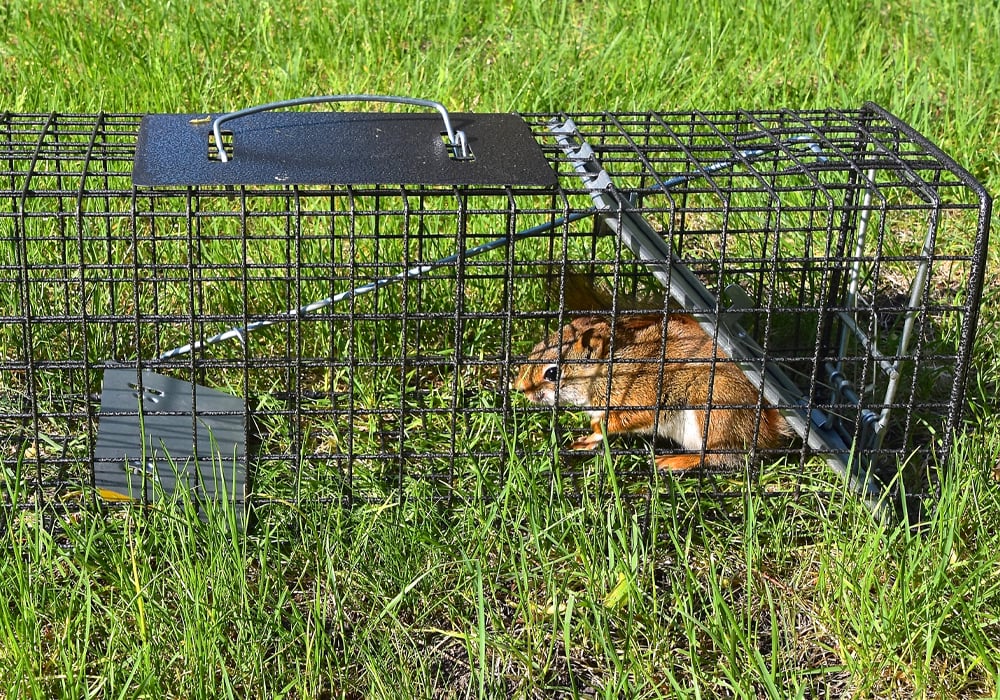
You can make your own bait using bird seed, fruits, grains, and nuts, or you can buy squirrel bait from the store. The advantage of the latter is that it is specially designed to attract squirrels.
Choose a squirrel trap that is humane, durable, and effective. This live squirrel trap is made to prevent injury to the captured animal. Double-check your trap before you install it to ensure that the spring mechanism is working and the door shuts securely.
Most importantly, make sure you check your traps very frequently. A humane live trap becomes a lot less humane when a squirrel is left inside to starve or dehydrate.
15. Install a fence
If you want to protect your home from squirrels, it starts at the perimeter of your property. You hit two birds with one stone when you have a good fence: it can get rid of squirrels in the house and in the garden.
But not just any fence will do. A squirrel-proof fence takes into consideration the animal’s ability to dig, climb, and nibble.
Use material that is strong and durable, like hardware cloth or chicken wire. Make sure the holes in the mesh are small, preferably around 1 inch wide, to make sure they don’t squeeze through.
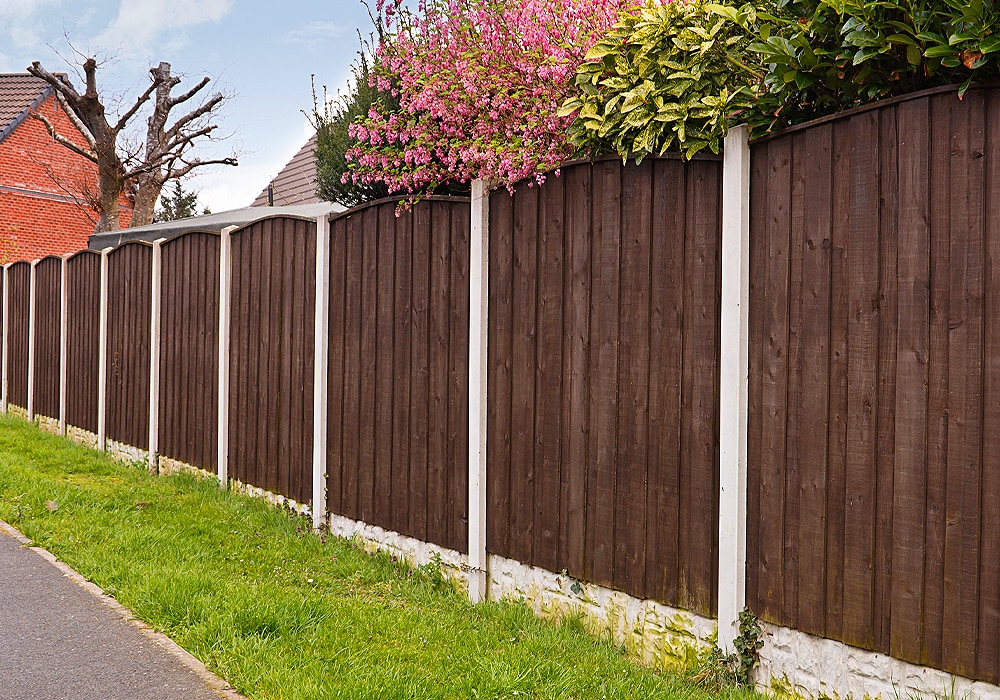
The mesh should be installed over the outward-facing surface of the posts. Leave at least one foot of mesh on the bottom to bury into the ground.
This thwarts any squirrels that think they can get in by digging under the fence. Prevent them from climbing over by installing an electric wire at the top.
Make sure that the fence has no loopholes. If there is a tree outside your property, prune its branches so that squirrels can’t use it to leap over the fence. A fence alone may not stop squirrels, but the more deterrents you combine together, the harder it will be for squirrels to bring their mischief into your yard.
Final Thoughts
My final note is this. While squirrels may be gluttonous at feeders, and squirrels in the house are certainly a problem, before we built our homes here this land was a playground of hills and trees and prairies where squirrels were free to roam. Be patient with your local wildlife. Try to appreciate their presence. It isn’t their fault that we’re living in close quarters together. Like any animal, they’re only trying to survive.
Related:

